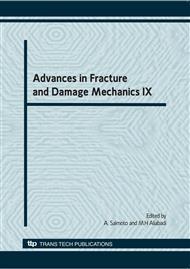p.845
p.849
p.853
p.857
p.861
p.865
p.869
p.873
p.877
Numerical Simulation of Rubber-to-Steel Bimaterial Bonded Interface Cracking Based on Cohesive Element
Abstract:
Presented herein is a finite element investigation into the damage mechanism of the adhesive interface of the rubber-steel bimaterial. The cohesive element layer is used at the interface to simulate the initial loading, initiation and propagation of the damage. From the simulation results, it is found that interface strength exert significant effects on the crack formation in the interface. Smaller interface strength could lead to crack initiation more easily.
Info:
Periodical:
Pages:
865-868
Citation:
Online since:
November 2010
Authors:
Price:
Сopyright:
© 2011 Trans Tech Publications Ltd. All Rights Reserved
Share:
Citation:


